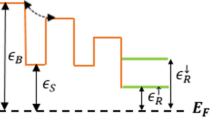Abstract
Planar defects, specifically grain boundaries, are now recognized as a major source of flux pinning in many materials, including the commercial A-15 superconductors. Unfortunately little theoretical attention has been devoted to the interaction between a planar pinning centre and the flux line lattice (FLL) of a type II superconductor. A Ginzburg-Landau perturbational approach is used here to calculate the pinning force per unit area exerted by a thin isolated planar defect upon the FLL. The pinning force is considered to arise from electron scattering at the defect plane, which creates a perturbation in the Ginzburg-Landau parameter,κ. The method of approach is of general applicability, however, and is easily adapted to other pinning mechanisms encompassed by the perturbational formalism. Second order terms in the FLL energy are retained, as well as all significant higher order terms in the Fourier transforms both of the superconducting electron density ¦ψ¦2, and of ¦ψ¦4. It is shown that a large error results, except at very high fields, if the above terms are ignored. The functional dependence of the elementary pinning force on temperature and field are shown to vary somewhat with the nature of the material and the pinning defect.
Similar content being viewed by others
References
A. M. Campbell andJ. E. Evetts,Adv. Phys. 21 (1972) 199.
H. Ullmaier, Springer Tracts in Modern Physics number 76 (Springer-Verlag, Heidelberg and New York, 1975) p. 1.
H. C. Freyhardt, “Radiation-Induced Flux Pinning in Type II Superconductors” (Institut fur Metallphysik, Universität Göttingen, Germany, 1976) p. 1.
E. J. Kramer,Phil. Mag. 33 (1976) 331.
C. S. Pande,Appl. Phys. Lett. 28 (1976) 462.
G. Zerweck,J. Low Temp. Phys. 42 (1981) 1.
W. E. Yetter, D. A. Thomas andE. J. Kramer,Phil. Mag. in press.
A. Das Gupta, C. C. Koch, D. M. Kroeger andY. T. Chou,Phil. Mag. B38 (1978) 367.
E. J. Kramer,J. Appl. Phys. 49 (1978) 742.
E. J. Kramer,J. Electonic Mater. 4 (1975) 839.
E. H. Brandt,Phys. Stat. Sol. (b) 51 (1972) 345.
B. Lischke andW. Rodewald, Proceedings of the International Discussion Meeting on Flux Pinning in Superconductors, Sonnenberg 1974, edited by P. Haasen and H. C. Freyhardt, Sonnenberg, September 1974 (Akademic der Wissenschaften, Göttingen, 1975) p. 322.
J. E. Evetts, private communication.
E. H. Brandt,Phys. Stat. Sol. (b) 84 (1977) 637.
Author information
Authors and Affiliations
Rights and permissions
About this article
Cite this article
Yetter, W.E., Kramer, E.J. Flux pinning by thin planar defects. J Mater Sci 17, 2792–2800 (1982). https://doi.org/10.1007/BF00644653
Received:
Accepted:
Issue Date:
DOI: https://doi.org/10.1007/BF00644653




